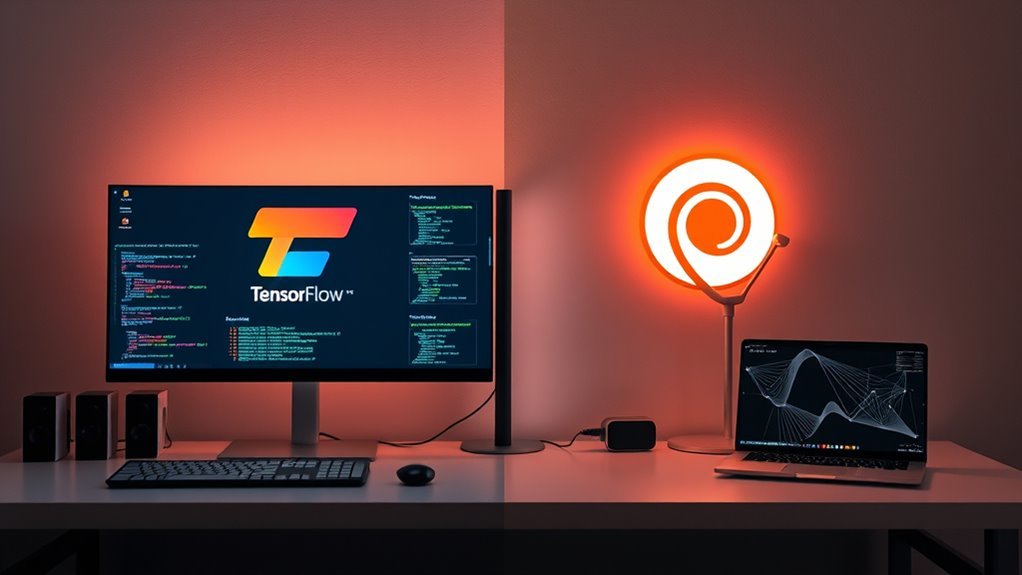If you need flexibility and intuitive debugging, PyTorch’s dynamic computation graph and Pythonic interface suit rapid prototyping and experimentation. TensorFlow offers superior scalability and performance with static graphs and TPU support, ideal for large-scale production and seamless deployment, especially on Google Cloud. TensorFlow’s structured APIs aid beginners, while PyTorch’s ease attracts research and startups. Your choice depends on whether you prioritize agile development or robust deployment, with more insights available on their distinct strengths and industry use cases.
Overview of TensorFlow and PyTorch

Both TensorFlow and PyTorch have become two of the most prominent frameworks for AI development, each offering distinct advantages depending on your project’s requirements. TensorFlow advantages include its robust deployment capabilities and scalability, allowing you to move models efficiently from research to production. PyTorch strengths lie in its dynamic computation graph, providing greater flexibility and intuitive debugging during model development. When conducting framework comparisons, you’ll find TensorFlow excels in large-scale environments, while PyTorch offers superior agility for experimentation. Model performance varies based on task complexity and hardware optimization, but both frameworks have matured to deliver competitive results. Choosing between them hinges on your need for freedom in model design versus streamlined deployment, making an informed evaluation critical for optimizing your AI development workflow.
Ease of Learning and Usability

When choosing between TensorFlow and PyTorch, you’ll notice distinct learning curves that impact how quickly you can become productive. PyTorch offers a more intuitive, Pythonic interface that simplifies model building and debugging, while TensorFlow’s extensive ecosystem introduces complexity but provides powerful user-friendly tools like TensorBoard. Understanding these differences helps you evaluate which framework aligns better with your development style and project requirements.
Learning Curve Differences
Although TensorFlow and PyTorch are powerful frameworks, you’ll find their learning curves differ considerably, impacting how quickly you can become proficient. TensorFlow offers thorough beginner resources and structured learning paths backed by extensive documentation quality, appealing to those favoring academic focus and industry preferences. PyTorch, on the other hand, emphasizes community engagement and intuitive skill development, often preferred for research and rapid prototyping.
| Aspect | TensorFlow | PyTorch |
|---|---|---|
| Beginner Resources | Extensive, official tutorials | Growing, community-driven resources |
| Tutorial Availability | Structured, formal | Flexible, experimental |
| Academic Focus | Strong, widely adopted | Increasing, research-oriented |
| Industry Preferences | Favored in production environments | Popular in innovation and startups |
Your choice influences how swiftly you adapt and excel.
User-Friendly Features
Two key aspects define the user-friendliness of TensorFlow and PyTorch: their interface design and debugging capabilities. When you choose a framework, consider how its user interface design and intuitive features align with your workflow, minimizing friction.
- TensorFlow offers extensive user documentation and robust accessibility options, empowering you to navigate complex models efficiently.
- PyTorch’s dynamic computation graph and straightforward API provide an intuitive experience, enhancing experimentation freedom.
- TensorFlow’s debugging tools are powerful but may require a steeper learning curve.
- PyTorch allows interactive debugging, giving you real-time feedback and control.
Model Building and Flexibility

Since flexibility in model building directly impacts your ability to experiment and optimize, understanding how TensorFlow and PyTorch differ in this aspect is essential. PyTorch offers dynamic computation graphs, granting you immediate feedback when customizing models, which enhances iterative development and debugging. This flexibility supports complex architectures and novel layers without cumbersome recompilation. TensorFlow, historically reliant on static graphs, has evolved with eager execution to bridge this gap, but its model customization still involves a steeper learning curve. For training optimization, PyTorch’s straightforward interface lets you fine-tune hyperparameters and integrate custom training loops seamlessly. TensorFlow provides robust high-level APIs like Keras, simplifying model assembly but sometimes limiting granular control. Ultimately, if you prioritize freedom in model customization and precise training optimization, PyTorch typically aligns better with those needs.
Performance and Speed Comparisons
When evaluating TensorFlow and PyTorch for AI development, understanding their performance and speed differences is essential for selecting the right framework for your specific use case. Performance benchmarks reveal that TensorFlow often excels in large-scale production environments due to its static computation graph, enabling advanced speed optimization. Conversely, PyTorch’s dynamic graph offers flexibility but can introduce slight overhead.
Consider these points:
- TensorFlow’s graph optimization can reduce runtime latency considerably.
- PyTorch’s enthusiastic execution favors rapid prototyping at some performance cost.
- Both frameworks leverage GPU acceleration effectively, but TensorFlow supports TPU integration.
- Speed optimization in TensorFlow often leads to better scalability for extensive datasets.
Choosing between them depends on whether you prioritize raw speed and scalability or flexible experimentation freedom.
Debugging and Error Handling
Although both TensorFlow and PyTorch offer robust debugging tools, you’ll find their approaches differ considerably, impacting how efficiently you can identify and resolve errors during development. PyTorch’s dynamic computation graph simplifies error tracking and exception handling, allowing you to debug interactively with standard Python tools. Its logging mechanisms integrate seamlessly with Python’s ecosystem, and its visualization techniques—like those in TensorBoardX or Matplotlib—enhance performance debugging. Conversely, TensorFlow employs a static graph model, which can complicate immediate error detection but benefits from advanced visualization tools like TensorBoard for detailed graph inspection. TensorFlow’s exception handling is more structured but may require additional setup. Ultimately, you’ll choose based on whether you prioritize immediate, flexible debugging (PyTorch) or thorough, visual performance debugging (TensorFlow) in your AI workflow.
Community and Ecosystem Support
Beyond debugging capabilities, the strength of a framework’s community and ecosystem can greatly influence your development experience and project scalability. When choosing between TensorFlow and PyTorch, consider how their support networks and community contributions enhance your freedom to innovate.
- TensorFlow boasts extensive development resources and a mature ecosystem growth driven by Google’s backing and numerous open source initiatives.
- PyTorch thrives on dynamic community events and collaborative projects, fostering rapid innovation through user forums and grassroots contributions.
- Both offer vibrant support networks, but PyTorch’s community is often praised for its accessibility and responsiveness, accelerating problem-solving.
- TensorFlow’s ecosystem includes a wide range of production-ready tools, while PyTorch emphasizes flexibility, enabling you to tailor solutions efficiently.
Your choice hinges on whether you prioritize stability or experimental freedom within the community and ecosystem support.
Deployment Options and Scalability
When deploying models, you’ll need to take into account how well TensorFlow and PyTorch integrate with cloud platforms and support various serving architectures. Your choice affects flexibility in model serving and the ability to scale efficiently under load. Understanding these factors is essential for optimizing performance and maintaining reliability in production environments.
Cloud Integration Capabilities
Since deploying AI models efficiently requires seamless cloud integration, understanding how TensorFlow and PyTorch handle deployment options and scalability is essential. Both frameworks boast robust cloud compatibility, but your choice depends on specific cloud service integration needs and desired control over scalability.
- TensorFlow’s tight integration with Google Cloud Platform offers streamlined deployment and auto-scaling, ideal if you want native cloud optimization.
- PyTorch provides flexible compatibility with AWS, Azure, and GCP, giving you freedom to choose your cloud environment.
- TensorFlow Serving simplifies scalable model deployment, reducing overhead when scaling across distributed systems.
- PyTorch’s ecosystem, including TorchServe, supports scalable inference but may require more manual setup, granting you granular control.
You’ll appreciate that both frameworks empower you to harness cloud infrastructure efficiently, balancing automation and freedom.
Model Serving Flexibility
Building on how these frameworks integrate with cloud platforms, it’s important to analyze their model serving flexibility, particularly regarding deployment options and scalability. TensorFlow’s TensorFlow Serving supports diverse serving architectures, allowing you to deploy models efficiently with built-in version control and seamless API integration. It offers robust resource management and monitoring tools, facilitating precise load balancing across instances. PyTorch, while traditionally focused on research, has expanded deployment capabilities through TorchServe, which supports flexible model deployment and API endpoints but may require more customization for advanced resource management. Both frameworks enable varied scaling strategies, but TensorFlow’s mature ecosystem grants you greater out-of-the-box operational control. Ultimately, your choice depends on how much freedom you want in balancing ease of deployment against fine-grained control over serving infrastructures.
Scalability and Performance
Although both TensorFlow and PyTorch offer robust deployment options, their scalability and performance characteristics differ considerably depending on your workload and infrastructure. You’ll find TensorFlow excels in horizontal scaling and distributed computing thanks to its mature ecosystem and advanced resource management tools. PyTorch, while improving, often requires more customization for ideal load balancing and vertical scaling.
Consider these factors when deciding:
- Infrastructure requirements: TensorFlow integrates seamlessly with cloud platforms, easing resource allocation.
- Performance enhancement: TensorFlow’s graph execution reduces latency, enhancing throughput.
- Latency considerations: PyTorch’s enthusiastic execution favors rapid prototyping but may increase inference time.
- Distributed computing: TensorFlow supports large-scale deployments more natively, ideal for expansive AI projects.
Your choice hinges on balancing freedom in customization with operational efficiency.
Compatibility With Other Tools and Libraries
Both TensorFlow and PyTorch offer extensive compatibility with a wide range of tools and libraries, but their integration capabilities differ in scope and ease. TensorFlow boasts robust library compatibility, seamlessly integrating with Google’s ecosystem, including TensorBoard for visualization and TensorFlow Extended for production pipelines. Its static graph architecture facilitates optimized tool integration, especially in deployment scenarios. Conversely, PyTorch emphasizes dynamic computation graphs, providing flexible tool integration that appeals to researchers requiring rapid experimentation. It supports popular libraries like torchvision and torchaudio natively, enhancing its ecosystem. If you value freedom to customize workflows, PyTorch’s straightforward Pythonic interface grants you greater control over library compatibility. TensorFlow’s thorough but sometimes rigid integrations suit large-scale, production-focused projects, while PyTorch’s modular approach empowers you to build and adapt tools fluidly.
Use Cases and Industry Adoption
When selecting a framework for AI development, understanding their distinct use cases and industry adoption patterns can guide your decision. TensorFlow excels in enterprise environments with robust domain specific tools and extensive deployment options, favored for real world applications demanding scalability. PyTorch leads in research and academia, praised for its dynamic computation graph and ease of experimentation.
Consider these factors:
Evaluate industry trends, project needs, performance, and community insights before choosing your AI framework.
- Industry preferences: TensorFlow dominates large-scale production; PyTorch appeals to innovation-driven sectors.
- Project requirements: TensorFlow suits stable, high-performance workloads; PyTorch fits rapid prototyping.
- Performance benchmarks: Both score well, but benchmarks vary by task and hardware.
- Community feedback and adoption trends: PyTorch’s growth reflects younger user demographics and research momentum, while TensorFlow maintains broad enterprise case studies.
Analyze competitive analysis and your project’s unique demands before committing.
Future Developments and Trends
You’ll need to monitor how both TensorFlow and PyTorch enhance their core architectures to support increasingly complex models and datasets. Expect tighter integration with emerging AI technologies, such as reinforcement learning and federated learning, to shape their development trajectories. Staying updated on these trends will be essential for optimizing your AI workflows and maintaining competitive advantage.
Evolving Framework Capabilities
As AI applications grow more complex, TensorFlow and PyTorch are rapidly advancing their capabilities to meet new demands. You’ll notice that evolutionary algorithms increasingly influence framework enhancements, driving more adaptive and efficient model training. These developments empower you with:
- Greater flexibility in customizing neural architectures.
- Enhanced computational efficiency for large-scale data.
- Streamlined integration of cutting-edge research techniques.
- Improved support for distributed and parallel computing.
Emerging AI Integration
Although both TensorFlow and PyTorch have established robust foundations, emerging AI integration is set to redefine how these frameworks interact with evolving technologies like edge computing, federated learning, and automated machine learning. You’ll notice AI integration strategies increasingly prioritize modularity and interoperability to harness these emerging technologies effectively. TensorFlow’s ecosystem is advancing with TensorFlow Lite and Federated Learning APIs, enabling distributed model training and deployment on constrained devices. PyTorch, meanwhile, is enhancing support for edge deployment and automation through TorchServe and integration with AutoML tools. As you adopt these frameworks, understanding their evolving AI integration capabilities becomes essential. This knowledge empowers you to select the ideal platform that aligns with your need for flexible, scalable AI solutions in dynamic environments where emerging technologies continually shift the landscape.



